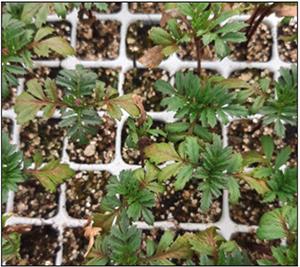Do you know how to interpret your water quality tests? This week, let’s start with a deeper understanding of alkalinity.
PROBLEM: When you send water samples off for testing and results come back, you need to know what to do with that information. The long list of water quality parameters that labs report can seem daunting when you receive the readout, so I’ll break it down into a few digestible chunks this week and next.
NICK’S TIP: First, let’s talk about alkalinity – arguably the most important water quality parameter to monitor and manage for floriculture producers who grow crops in soilless media.

Alkalinity Core Concepts
Not to be confused with the term “alkaline” (meaning a pH above 7.0), alkalinity is a measure of your water’s buffering capacity – its ability to neutralize acid. Alkalinity is most often reported as ppm CaCO3 (sometimes written as mg/L; 1 ppm = 1 mg/L) or meq/L. This value indicates the concentration of calcium, magnesium and sodium carbonates and/or bicarbonates present in your water. As water reacts with things like fertilizer (water-soluble [WSF] or controlled-release [CRF]), soil amendments, acids produced by roots in the growing media and the growing media itself, these carbonates and bicarbonates break down, causing soil pH to increase over time. Keep the following in mind as you review alkalinity on your water report:
• The top take-home message is … too-high alkalinity often means more crop challenges.
• About 50 ppm CaCO3 = 1 meq/L (milliequivalent)
• Ideal alkalinity levels for greenhouse growers range from about 50 to 75 ppm CaCO3.
• Alkalinity greater than 75 ppm often makes high-quality young plant production challenging. Alkalinity between 75 and 150 ppm is often workable for finished plant production simply by using an acidic fertilizer formulation. Minimal intervention is generally needed, but low-pH-loving crops (like Petunia and Calibrachoa) may develop iron (Fe) deficiency later in production if alkalinity is on the higher end of this range.
• Alkalinity greater than 150 ppm often requires raw water to be acidified through a separate injection system before blending with WSF.
AlkCalc (currently hosted by our friends at e-GRO) is a great online tool that you can use to determine how much acid is needed to bring your alkalinity down to a manageable level. Be sure to check it out.
Sulfuric acid is one of the preferred acids among growers, as it is relatively easy to source and doesn’t heavily alter the nutrient balance of your fertilizer solution.
Phosphoric and nitric acids are other options commonly used to manage alkalinity. However, these will increase the total phosphorous (P) and nitrogen (N) levels (respectively) in your feed. For example (per AlkCalc): If alkalinity is 180 ppm CaCO3 and you want to lower it to 125 ppm, sulfuric acid will add approximately 27 ppm of sulfur (S), whereas phosphoric acid will add about 50 ppm of P. Adding 27 ppm of S likely won’t change anything but 50 ppm of P is a lot more P than plants need, and it will undoubtedly have a negative impact on crop quality.
Too-low alkalinity (less than 40 ppm CaCO3), while less common, presents its own set of unique challenges. Think of your target soil pH like a lane in a bowling alley and appropriate amounts of alkalinity in your water like bumpers.
• Bumpers prevent your ball from rolling into the gutter and help keep the ball (roughly) in the center of the lane. In a similar way, alkalinity helps keep your soil pH “out of the gutter” by neutralizing various acids in the media.
• To replenish your buffer or “get the bumpers to pop up each time it’s your turn to bowl,” small doses of alkalinity need to be added to the media at each irrigation.
• Since low-alkalinity water does not replenish much buffering capacity (or “raise the bumpers”), it becomes easier for soil pH to spike or crash as your media’s lime charge depletes. In turn, this causes nutrient deficiencies and toxicities to induce very quickly as the soil pH swings up and down, especially as the crop matures and acidic reactions (such as respiration and cation uptake) in the root zone occur in greater quantity.
When alkalinity in your water is excessively high (ex. greater than 250 ppm CaCO3), acid injection alone may not be enough to correct it without being cost-prohibitive or causing nutrient imbalances in your feed program.
• In this situation, use of reverse osmosis (RO) is often necessary, despite the typically high cost of installing and maintaining these types of systems.
• Blending RO water with raw water can reduce alkalinity to acceptable levels for good crop growth or make it feasible for acid injection and fertilizer selection to “do the rest.”